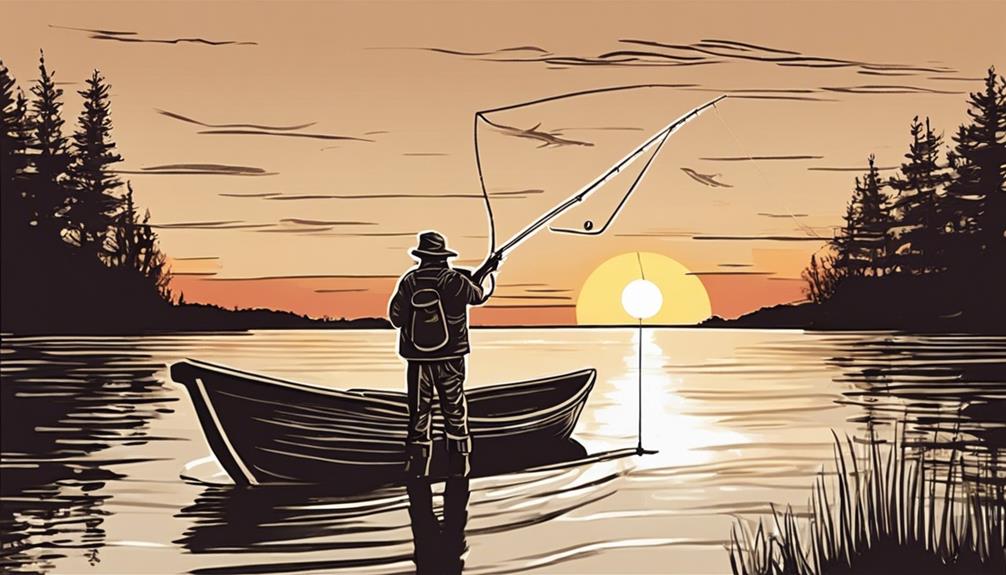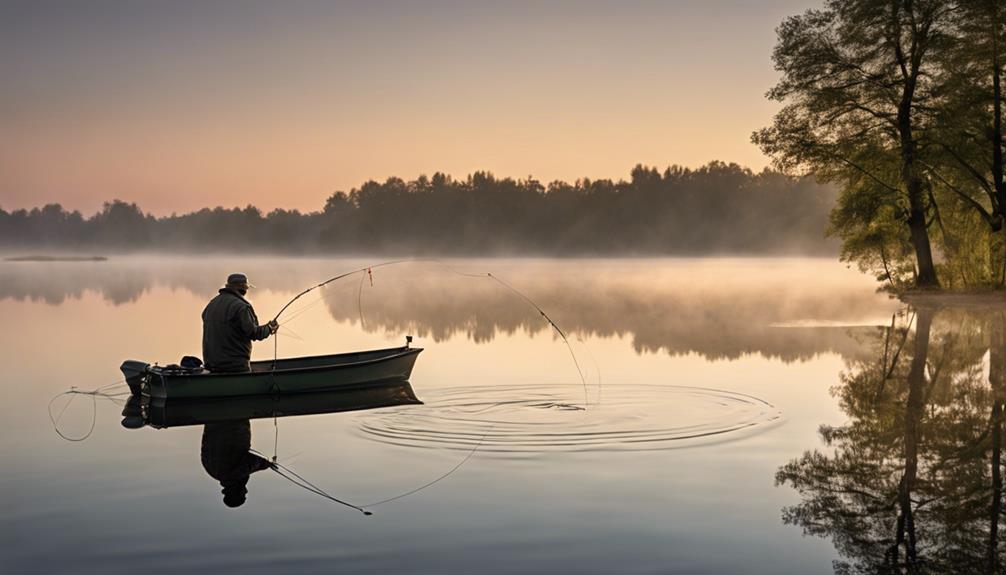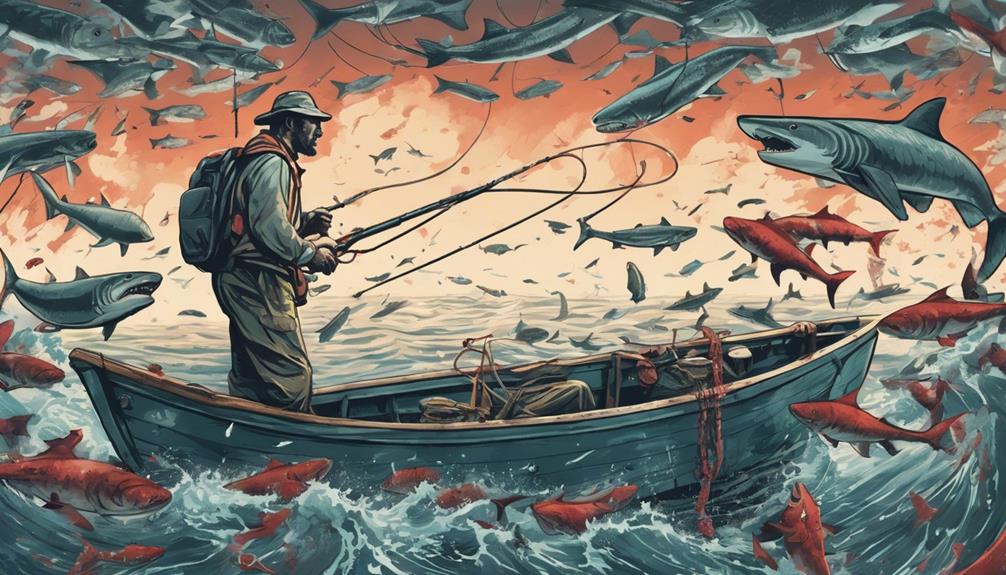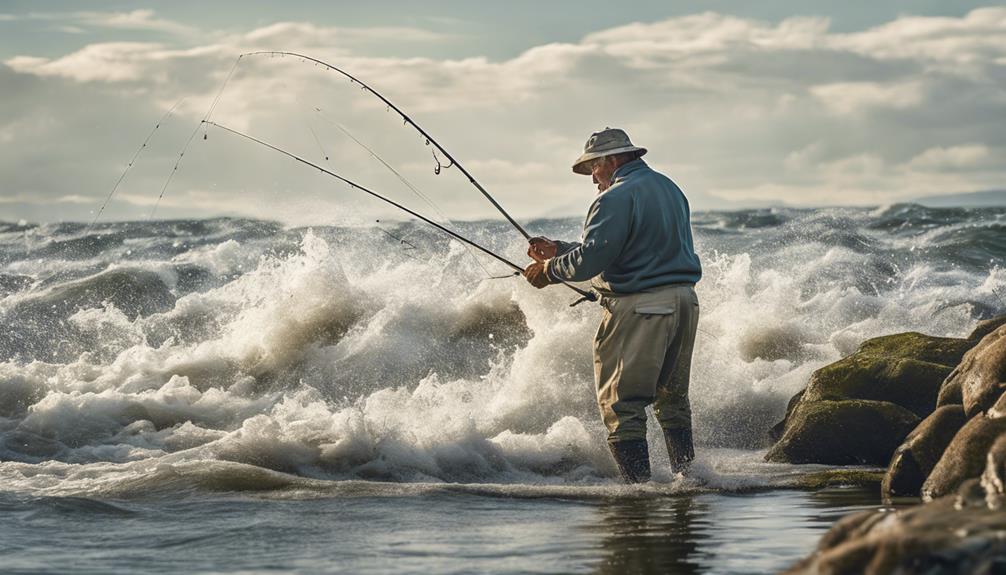Did you know that bow fishing has been gaining popularity in recent years, with over 1.5 million participants in the United States alone?
Mastering bow fishing techniques can be a rewarding experience for beginners looking to try something new and exciting. Understanding the basics is crucial, from selecting the right gear to honing your shooting skills.
Stay tuned to discover some easy techniques that will set you on the path to becoming a successful bow fisherman.
Getting Started With Bow Fishing
Are you ready to dive into the exciting world of bow fishing? The first steps in getting started involve bow selection and target practice. Let's start by discussing bow selection.
When choosing a bow for fishing, you want to consider a few key factors. Look for a bow with a draw weight that you can comfortably handle. Since bow fishing requires quick shots in potentially challenging conditions, a lighter draw weight may be more suitable for beginners. Additionally, consider the bow's axle-to-axle length – a shorter bow is easier to maneuver in tight spaces like a boat or a small fishing platform.
Moving on to target practice, honing your skills is essential for successful bow fishing. Set up targets that mimic the size and movement of the fish you'll be targeting. Practice shooting from different distances and angles to prepare for real-life fishing scenarios. Focus on accuracy and precision to increase your chances of hitting your target when out on the water. Regular target practice will also help you get comfortable with your bow and build muscle memory for quick, accurate shots.
Choosing the Right Bow for Fishing
Considering your skill level and the demands of bow fishing, selecting the right bow is crucial for your success on the water. When choosing a fishing bow, equipment essentials and beginner tips are key factors to keep in mind. Here are some pointers to help you make the best decision:
- Bow Selection: Opt for a compound bow for better accuracy and power. Compound bows have a pulley system that makes it easier to hold at full draw, allowing for steadier shots. They're also adjustable, which is beneficial as you refine your technique.
- Draw Weight: For beginners, a bow with adjustable draw weight is ideal. Starting with a lower draw weight allows you to focus on your form and accuracy before gradually increasing the weight as you build strength and skill.
- Bow Length: Choose a shorter bow for maneuverability in tight spaces such as on a boat or in dense vegetation along the shoreline. Shorter bows are easier to handle and aim in confined areas.
- Accessories: Consider investing in a bowfishing reel, specialized bowfishing arrows, and a bowfishing rest. These accessories are designed to enhance your bow fishing experience, making it more efficient and enjoyable.
Selecting the Proper Arrows
When selecting the proper arrows for bow fishing, focus on factors like material, weight, and tip design to optimize your shooting performance. Arrow weight plays a crucial role in accuracy. Heavier arrows tend to penetrate deeper but may sacrifice some speed, while lighter arrows offer increased velocity but may lack the necessary punch for larger fish. It's essential to find a balance that suits your shooting style and the type of fish you target.
Arrow material is another critical aspect to consider. The material affects the arrow's durability and performance. Fiberglass arrows are durable and affordable, making them a popular choice for beginners. Carbon arrows are lighter and faster, offering better accuracy and penetration. Aluminum arrows are also a reliable option, offering a balance between durability and performance. Choose the material that aligns with your skill level and budget.
Additionally, pay attention to the tip design of the arrows. Bow fishing arrows typically feature barbed tips to prevent the fish from slipping off once they're hit. These tips ensure a secure hold, especially when dealing with larger fish or fast-moving targets. Selecting arrows with the right tip design can significantly improve your success rate while bow fishing.
Understanding Bow Fishing Regulations
To ensure compliance and safety while participating in bow fishing, familiarize yourself with the relevant regulations in your area. Understanding bow fishing regulations is crucial to enjoying this activity responsibly. Here are some key points to keep in mind:
- License Requirements: Before engaging in bow fishing, make sure you have the necessary permits or licenses. Different states and regions may have specific requirements for bow fishing, including permits related to fishing regulations.
- Fishing Spots: Be aware of designated bow fishing areas. Not all water bodies may allow bow fishing, so it's essential to know where you can legally practice this activity. Respect any restrictions on certain species or locations.
- Safety Guidelines: Follow all safety protocols to prevent accidents. This includes using appropriate gear, maintaining a safe distance from other anglers, and being mindful of your surroundings while bow fishing.
- Gear Recommendations: Invest in quality bow fishing equipment. This may include a specialized bow fishing bow, arrows designed for fishing, and appropriate fishing reels. Using the right gear not only enhances your experience but also ensures the humane treatment of the fish you catch.
Practicing Proper Shooting Techniques
For effective bow fishing, mastering proper shooting techniques is essential to enhance your accuracy and success in catching fish. When it comes to target acquisition, make sure to focus on the fish's position in the water. Adjust your stance accordingly, ensuring stability and a clear line of sight. Your stance should be balanced, with your feet shoulder-width apart and body facing the target.
Release timing is crucial for a successful shot. Wait for the right moment when the fish is within range and in a good position for a clean hit. Practice releasing the arrow smoothly and consistently to maintain accuracy. Consider the trajectory of the arrow, aiming slightly lower than the fish to account for refraction in the water.
To improve your shooting techniques, regular practice is key. Set up targets to simulate different fishing scenarios and work on your aim and timing. Experiment with different release timings and angles to find what works best for you. Additionally, consider seeking guidance from experienced bow fishers to learn advanced techniques and tips.
Locating Fish in Different Environments
Mastering the skill of locating fish in various environments is crucial for successful bow fishing expeditions. When bow fishing, understanding fish behavior and camouflage techniques can significantly increase your chances of a successful catch. Here are some tips to help you locate fish effectively:
- Study Fish Behavior: Observing how fish move and where they tend to gather can guide you to the best spots for bow fishing. Look for signs of feeding or breeding activities to increase your chances of spotting fish.
- Utilize Camouflage Techniques: Blend in with your surroundings by wearing camouflage clothing or using a boat blind. This will help you remain undetected by fish, allowing you to get closer for a more accurate shot.
- Consider Weather Conditions: Different weather conditions can impact fish behavior. On sunny days, fish may move to deeper waters to escape the heat, while they may become more active near the surface during overcast weather. Adjust your fishing strategy accordingly.
- Evaluate Visibility Factors: Factors such as water clarity and light conditions can affect your ability to spot fish. Choose spots with good visibility and consider using polarized sunglasses to reduce glare and improve your vision underwater.
Retrieving Your Catch Safely
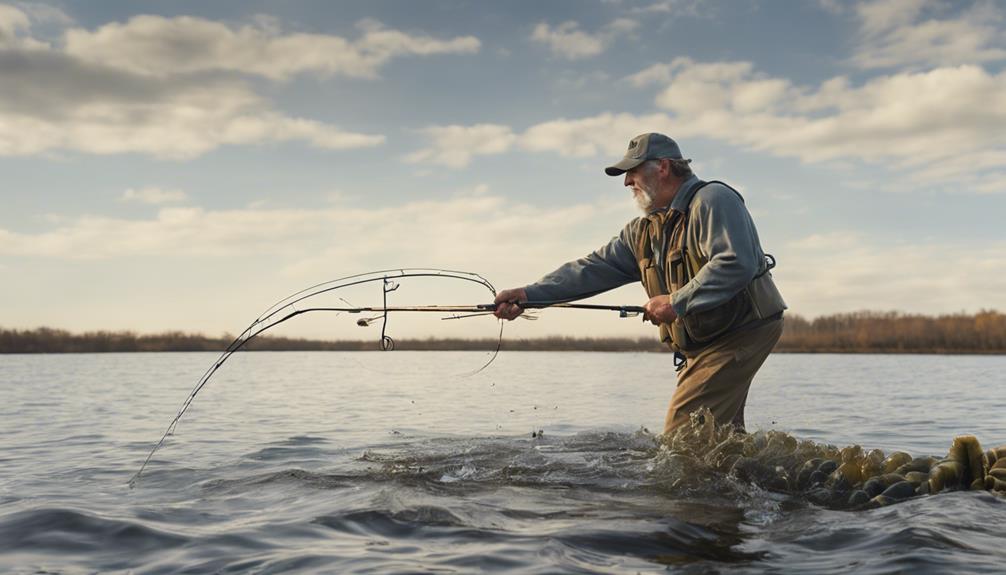
Safely retrieving your catch requires careful handling techniques to ensure the preservation of both the fish and your equipment. After successfully landing your target, the first step is to approach the fish cautiously. Avoid causing unnecessary harm by firmly but gently grasping the fish to prevent it from thrashing around. Safe handling is crucial not only for the well-being of the fish but also for your own safety.
Once you have a secure hold on the fish, it's time to consider the method of release. If you plan to keep the fish, ensure you have the necessary tools for cleaning and storing it properly. However, if you intend to release the fish back into the water, quick release is key. Use a pair of fish-friendly pliers to carefully remove the arrow, taking care not to cause further injury. Support the fish in the water until it revives and swims away on its own.
Maintenance Tips for Bow Fishing Gear
After successfully retrieving your catch and ensuring its safe release, maintaining your bow fishing gear is essential for optimal performance and longevity. Proper gear maintenance and equipment care won't only extend the life of your equipment but also ensure that it functions effectively every time you head out for a bow fishing adventure.
Here are some maintenance tips for your bow fishing gear:
- Clean Your Equipment Regularly: After each use, make sure to clean your bow, arrows, reel, and other gear with a damp cloth to remove any dirt, sand, or debris that could cause damage.
- Inspect for Wear and Tear: Routinely check your gear for any signs of wear and tear such as fraying bowstrings or loose arrow tips. Replace any damaged components to prevent accidents and maintain accuracy.
- Apply Lubrication: To keep moving parts working smoothly, apply lubrication to components like the reel, arrow rest, and bow sight. This will prevent rust and corrosion, ensuring everything operates seamlessly.
- Store Properly: When not in use, store your bow fishing gear in a cool, dry place away from direct sunlight. This will help prevent warping of the bow and deterioration of the strings.
Frequently Asked Questions
How Can I Improve My Aim and Accuracy When Bow Fishing?
To improve your aim and accuracy when bow fishing, focus on target practice. Try different techniques to find what works best for you. Concentrate on your form and breathing to steady your shot.
With regular practice and determination, your aim will improve over time. Keep refining your skills and stay patient with yourself as you work towards better accuracy on the water.
Are There Any Specific Safety Precautions I Should Take While Bow Fishing?
When bow fishing, prioritize safety by wearing appropriate gear such as polarized sunglasses and a life jacket. Always be aware of your surroundings and never point your bow at anyone. Have emergency procedures in place, such as knowing how to safely release your arrow if needed and having a first aid kit on hand.
What Are Some Common Mistakes Beginners Make When Bow Fishing?
When bow fishing, common errors beginners make include not adjusting to the refraction of water, aiming too high or low, and not considering the depth of the target.
To avoid these mistakes, focus on practicing your aim and adjusting for the water's distortion. Remember to aim slightly lower than the fish appears. Also, be aware of the target's depth to ensure an accurate shot.
These beginner tips will help improve your bow fishing skills.
Can You Recommend Any Accessories or Additional Gear That Would Enhance My Bow Fishing Experience?
To enhance your bow fishing experience, consider investing in the best lighting for visibility and proper clothing for comfort and safety.
A bright headlamp or LED light can help you spot fish in murky waters. Also, wear breathable, quick-drying clothes to stay comfortable during long fishing sessions.
These accessories will make your bow fishing trips more enjoyable and successful.
How Can I Effectively Clean and Maintain My Bow Fishing Equipment to Ensure Its Longevity?
To effectively clean and maintain your bow fishing equipment for longevity, remember these key tips.
Proper storage is crucial; keep your gear in a dry and secure place to prevent damage.
Regular maintenance is essential; clean your equipment after each use, check for any signs of wear and tear, and replace any worn-out parts promptly.
Conclusion
Now that you have learned the basics of bow fishing, remember to practice regularly, follow regulations, and always prioritize safety.
With the right gear and techniques, you can enjoy this exciting sport and improve your skills over time.
Keep exploring new fishing spots, honing your shooting accuracy, and taking care of your equipment to ensure a successful and enjoyable bow fishing experience.
Happy fishing!
